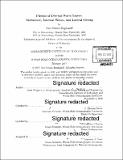Physics of diurnal warm layers : turbulence, internal waves, and lateral mixing
Author(s)
Bogdanoff, Alec Setnor
DownloadFull printable version (20.15Mb)
Other Contributors
Woods Hole Oceanographic Institution.
Advisor
J. Thomas Farrar and Carol Anne Clayson.
Terms of use
Metadata
Show full item recordAbstract
The daily heating of the ocean by the sun can create a stably stratified near-surface layer when the winds are slight and solar insolation is strong. This type of shallow stable layer is called a Diurnal Warm Layer (DWL). This thesis examines the physics and dynamics of DWLs from observations of the subtropical North Atlantic Ocean associated with the Salinity Processes in the Upper ocean Regional Study (SPURS-I). Momentum transferred from the atmosphere to the ocean through wind stress becomes trapped within the DWL, generating shear across the layer. During SPURS-I, strong diurnal shear across the DWL was coincident with enhanced turbulent kinetic energy (TKE) dissipation ([epsilon], [epsilon] > 10⁻⁵ W/kg) observed from glider microstructure profiles of the near-surface. However, a scale analysis demonstrated that surface forcing, including diurnal shear, could not be the sole mechanism for the enhanced TKE dissipation. High-frequency internal waves ([omega] >> f) were observed in the upper ocean during the daytime within the DWL. Internal waves are able to transfer energy from the deep ocean into the DWL through the unstratified remnant mixed layer, which is the intervening layer between the DWL and seasonal thermocline. As the strength of the stratification of the DWL increases, so does the shear caused by the tunneling internal waves. The analysis demonstrates that internal waves can generate strong enough shear to cause a shear-induced instability, and are a plausible source of the observed enhanced TKE dissipation. Vertically-varying horizontal transport across the upper ocean occurs because a diurnal current exists within the DWL, but not in the unstratified remnant mixed layer below. Therefore, when a DWL is present, the water within DWL is horizontally transported a different distance than the water below. Coupled with nocturnal convection that mixes the DWL with the unstratified layer at night, this cycle is a mechanism for submesoscale (1-10 km) lateral diffusion across the upper ocean. Estimates of a horizontal diffusion coefficient are similar in magnitude to current estimates of submesoscale diffusion based on observations, and are likely an important source of horizontal diffusion in the upper ocean.
Description
Thesis: Ph. D., Joint Program in Oceanography/Applied Ocean Science and Engineering (Massachusetts Institute of Technology, Department of Earth, Atmospheric, and Planetary Sciences; and the Woods Hole Oceanographic Institution), 2017. Cataloged from PDF version of thesis. Includes bibliographical references (pages 167-179).
Date issued
2017Department
Joint Program in Oceanography/Applied Ocean Science and Engineering; Woods Hole Oceanographic Institution; Massachusetts Institute of Technology. Department of Earth, Atmospheric, and Planetary SciencesPublisher
Massachusetts Institute of Technology
Keywords
Joint Program in Oceanography/Applied Ocean Science and Engineering., Earth, Atmospheric, and Planetary Sciences., Woods Hole Oceanographic Institution.